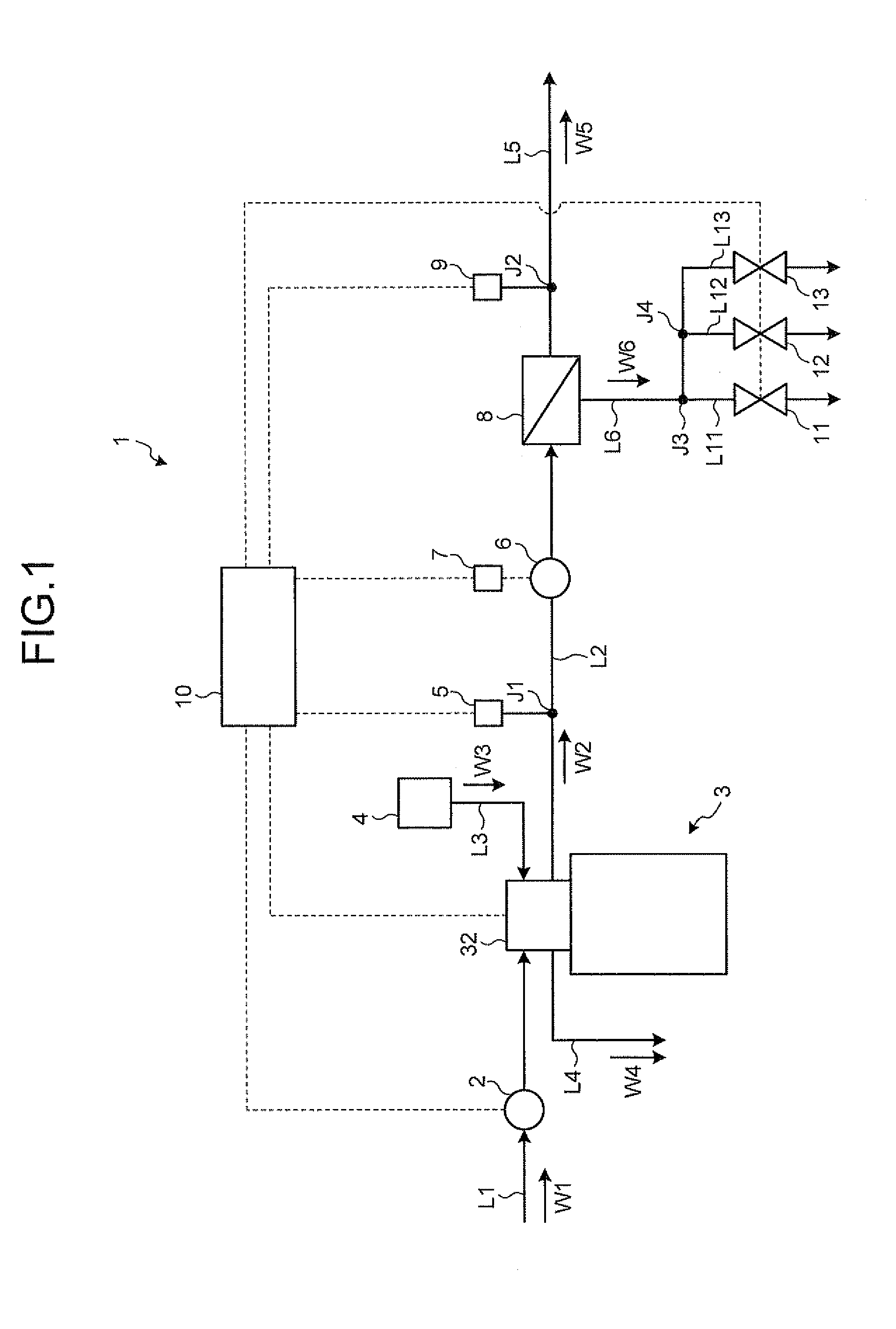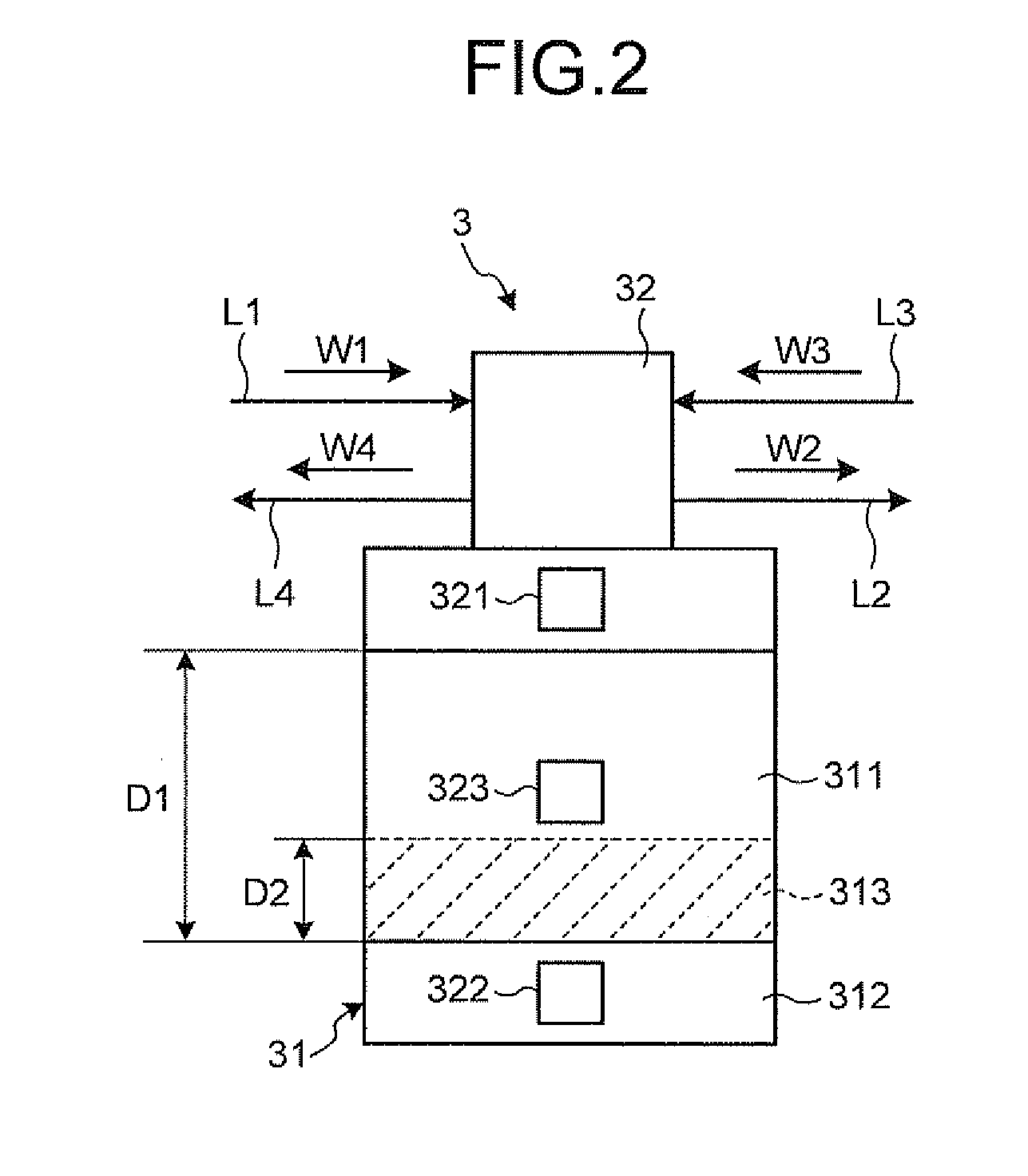Water treatment system
a water treatment system and water softening device technology, applied in the direction of moving filter element filters, filtration separation, separation processes, etc., can solve the problems of inability to suppress the occurrence of silica scale and fouling, the inability of the water softening device to remove the silica component and the suspended substance contained in raw water, and the inability to remove the silica scale and the suspended substance easily
- Summary
- Abstract
- Description
- Claims
- Application Information
AI Technical Summary
Benefits of technology
Problems solved by technology
Method used
Image
Examples
first embodiment
[0024]A water treatment system 1 according to a first embodiment of the present invention is described with reference to the drawings. The water treatment system 1 is applied to a pure water production system that produces pure water from fresh water, for example. FIG. 1 is an overall configuration diagram of the water treatment system 1 according to the first embodiment. FIG. 2 is a schematic cross-sectional view of a water softening device 3. FIG. 3 is a flowchart of a process that is performed by a control unit 10. FIGS. 4A and 4B are explanatory diagrams showing a basic process that is performed by the control unit 10.
[0025]As shown in FIG. 1, the water treatment system 1 according to the first embodiment includes a raw water pump 2, the water softening device 3, a salt water tank 4 as a regenerant supply unit, and a temperature sensor 5 as a temperature detecting unit. The water treatment system 1 further includes a pressure pump 6, an inverter equipment 7, an RO membrane modul...
second embodiment
[0108]A water treatment system 1A according to a second embodiment of the present invention is described with reference to FIG. 7. FIG. 7 is an overall configuration diagram of the water treatment system 1A according to the second embodiment. In the second embodiment, differences from the first embodiment are mainly described. In a description of the second embodiment, configurations that are the same as or equivalent to those in the first embodiment are assigned with the same reference numerals or symbols. In the second embodiment, a description redundant with that of the first embodiment is suitably omitted.
[0109]As shown in FIG. 7, the water treatment system 1A according to the second embodiment includes the raw water pump 2, the water softening device 3, the salt water tank 4, the temperature sensor 5, the pressure tank 6, the inverter equipment 7, and the RO membrane module 8. The water treatment system 1A also includes a control unit 10A, the first drain valve 11 to the third ...
third embodiment
[0142]A water treatment system 1B according to a third embodiment of the present invention is described with reference to FIG. 10. FIG. 10 is an overall configuration diagram of the water treatment system 1B according to the third embodiment. In the third embodiment, differences from the first embodiment are mainly described. In a description of the third embodiment, configurations that are the same as or equivalent to those in the first embodiment and the second embodiment are assigned with the same reference numerals or symbols. In the third embodiment, a description redundant with that of the first embodiment and the second embodiment is suitably omitted.
[0143]As shown in FIG. 10, the water treatment system 1B according to the third embodiment includes the raw water pump 2, the water softening device 3, the salt water tank 4, the temperature sensor 5, the pressure pump 6, the inverter equipment 7, and the RO membrane module 8. The water treatment system 1B also includes a control...
PUM
| Property | Measurement | Unit |
|---|---|---|
| electric conductivity | aaaaa | aaaaa |
| depth D1 | aaaaa | aaaaa |
| depth | aaaaa | aaaaa |
Abstract
Description
Claims
Application Information
 Login to View More
Login to View More - R&D
- Intellectual Property
- Life Sciences
- Materials
- Tech Scout
- Unparalleled Data Quality
- Higher Quality Content
- 60% Fewer Hallucinations
Browse by: Latest US Patents, China's latest patents, Technical Efficacy Thesaurus, Application Domain, Technology Topic, Popular Technical Reports.
© 2025 PatSnap. All rights reserved.Legal|Privacy policy|Modern Slavery Act Transparency Statement|Sitemap|About US| Contact US: help@patsnap.com



